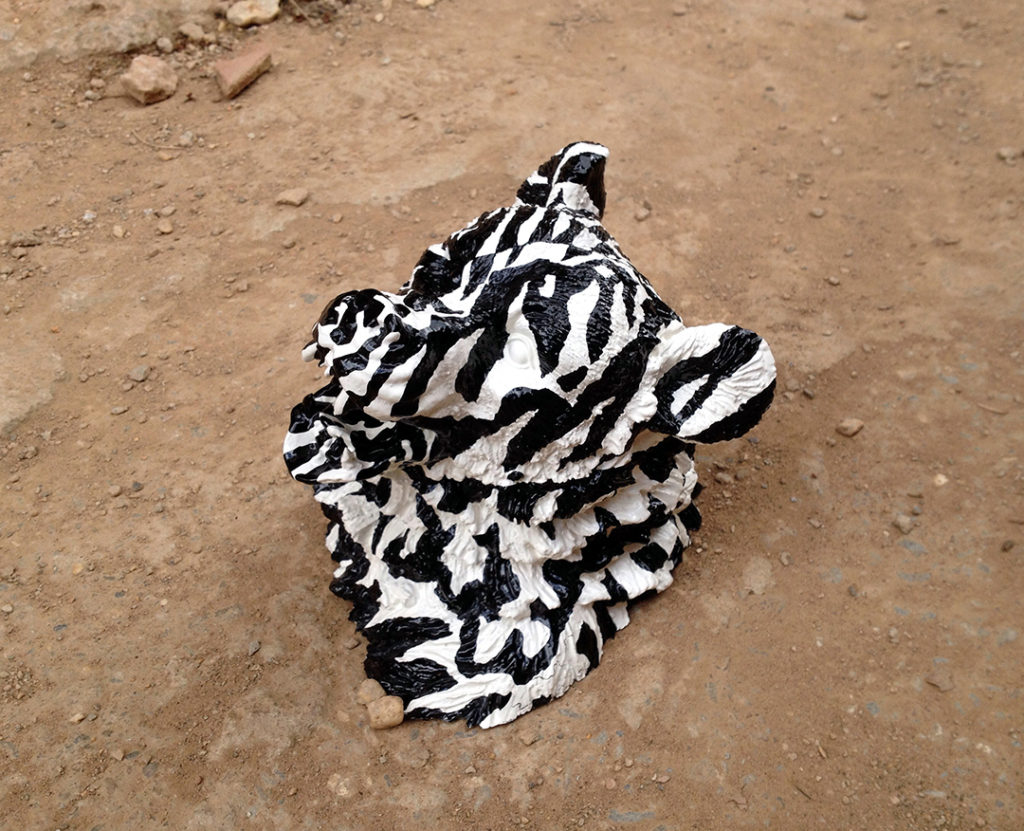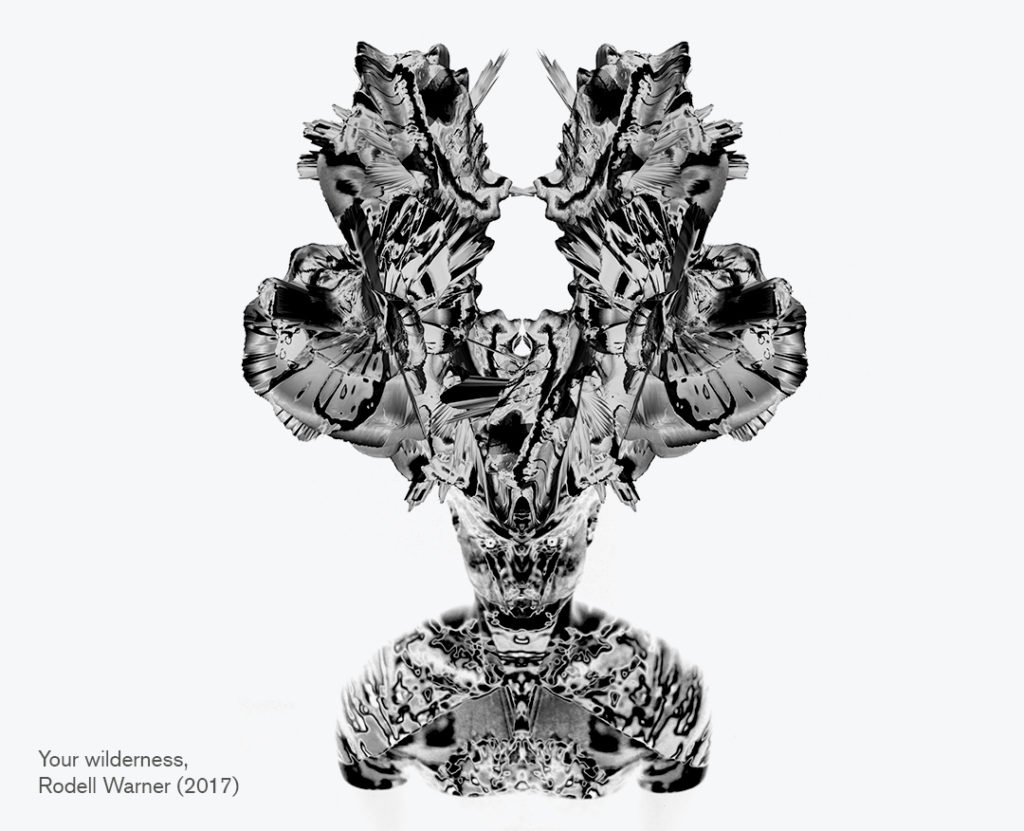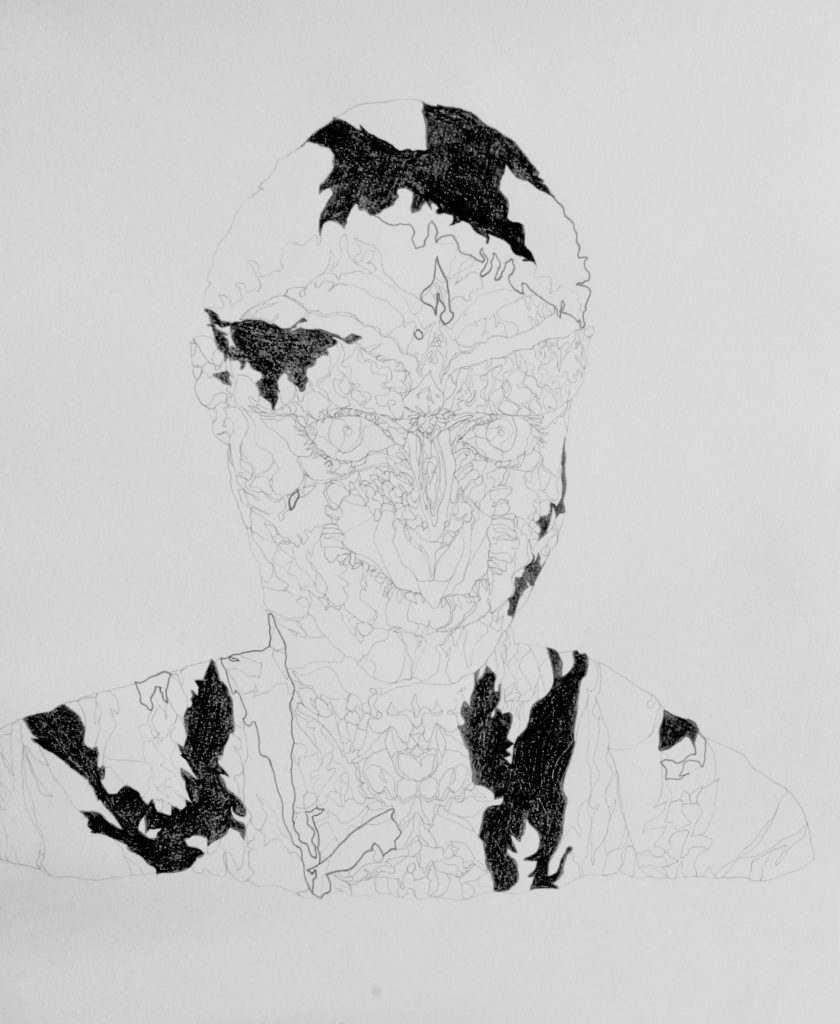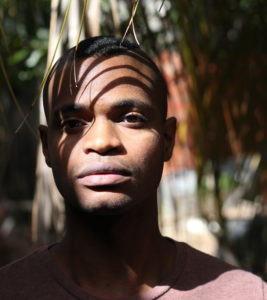As I enter the rust coloured gate, which Rodell locks twice while greeting me with a serene and almost timid smile, I’m pleasantly surprised by the contrast in scenery between the main street I just walked up, lined so tightly with offices and cars that everything seemed almost stuck together in one rainy, grey filter, and the cosiness of the walkway which awaits us. As we make our way down the narrow alley leading to his studio in Port of Spain for our interview, I realise that I enjoy being led by my guide, I enjoy being able to trust him. My guide is incredibly agile and light in his steps. We play hopscotch avoiding raindrops, puddles of water, pieces of red brick scattered along the pathway; I feel so much excitement to be in this new place, where I feel like an adventurer. There is a light, childlike playfulness in the air coupled with insouciance of not knowing where we are going, nor what I will discover in talking to Rodell Warner about his new body of work.

With just about 8 years of digital portraiture and photo based work, Rodell Warner states that “Digital work always feels digital, intangible, and somehow never as real as a painting.” He has done work for public events and Art Fairs (Art Basel, Switzerland; Germany), creating experiences for audiences with his camera and via projection for over hundreds of people each time. A recurring subject in Warner’s work is Portraiture, and very often Self-Portraiture, as seen in his most recent work over the past year where he has created a number of digital, black and white self-portraits. Curious to find out the motivation behind repeated self-portraits, Warner explains “Portraiture is a presentation of yourself, how one wants to be perceived, very often in the most composed way. With self-presentation, the artist is composing… exploring what a person could be.” He also adds that “This is the only way to be really valuable to society. Self-portraiture often seems antisocial; however, it is actually a healthy investigation of yourself,” and therefore useful at the end. Throughout our human life and interactions, “We are a collection of experiences… and once I had produced enough about myself I understood what I wanted to do – to, or for other people.”

Transition
Warner is at a new moment in his career, and explains that he is applying what he has done in terms of drawing and use of layers … “I’ve always loved drawing and lines,” a distinct technique visible in his work. Currently, Warner is working on a series of colourful figurative paintings stemming from a desire to use more traditional and ‘relatable’ techniques. “There is a Continuum: Relatable <> Valuable to more people, which exists because of our long tradition of drawing and painting. It seems more relatable to us as humans.” He adds that “When you make something with your hands, more people are able to relate to it. People somehow seem to enjoy it more, and there is a value in knowing that another person made and created this item or object. It is also a recognition of what could be impossible for some. That is amazing.” In contrast with his previous drawings, which were based on digital work, he admits that he is “Now learning how to draw and paint again.” Postures in the new series are “Based on recordings of persons dancing, giving up control, in states of less composure… I want to focus on less composure, as there is a deliberate pulling apart, distortion and decomposure.” Distortion is another central element in Warner’s work, where this ‘pulling apart’ and dissecting were accomplished through intricate, kaleidoscopic projections of camouflage patterns on people’s faces and bodies in his earlier work.
About Usefulness, Connections and Deliciously Surprising Work
In speaking about his current work, which he describes as introspective and reflective, Warner has a profound desire to ‘Harness the Good’. “This work is about doing something new… learning, finding out what makes an artist useful,” and equally, “Searching for what I could make… in an effort to connect to people.” “I want to make surprising images of people with my hands, images that are visually delicious.” Warner explains that delicious work is “Surprising, but also visually nice, comforting, well-known.”
Ideas are Broccoli
In my attempt to explain the element of surprise in creating art, I compare ideas to broccoli – Warner’s eyes light up and he points out that my very reference is exactly what an idea would look like, were it tangible; One idea branches off, to become another, then another, then another… Indeed, the idea is just the beginning. “Doing is the surprising part. While doing, it creates opportunity, surprises, that can only come by doing. You are even surprising yourself, by creating anything. You are making LIFE – something that is alive.”

Does Life Imitate Art, or does Art Imitate Life?
Warner believes “All of our energies as human beings go towards making and duplicating this huge world of ARTWORK. We are consuming this ARTWORK. Everything is Art.” After a pensive moment, Warner adds that “Art is a tool. Art could also be a product. Every artist uses Art as a tool, to play, to work, etc… and also a means of engaging society,” as in his case. Warner describes himself as a person exploring what it means to be alive, exploring the process of maturing and finding things out.

Art as raw material? An end product? We both agree that defining Art is a limiting exercise, and Warner jests that maybe it should not be done. “There can be as many roles for Artists as there are Artists, because every artist is reinventing the range of behaviours, products, that we call Art.” All of these possibilities of what Art could be, constitute the transcendental and even sacred nature of Art for Warner. He draws the parallel between Love and Art: “Love, in our society, is a sacred thing because it is taboo. Art is sacred and taboo in the same way.” Regarding the purpose of Art, Warner is convinced that “You make Art because there is something you need or want from it as an artist,” and he admits “I can see how the work I do responds to a need,” and relates the process and story behind his first body of work. In 2009, he had just moved out from home, which was an entirely new experience with new codes, living away from his family. He found it difficult to make eye contact with people, which seemed awkward. Incidentally, his first body of work was called Closer (2009): a direct investigation of that dis-ease, uneasiness, or awkward feeling that he had when meeting eye to eye with strangers in the street, which he subconsciously wanted to address. He admits that “The reason behind any project is getting information. Setting up an experiment. Creating conditions to find out more…” As our conversation comes to an end, I ask Rodell to share his thoughts about the role of an Artist and of Creatives in our societies, and our world. He starts off by saying, “We need and therefore search to find in the world, things that make us want to be here… things that help us enjoy a moment… perhaps our role is to put something in the world that makes being in the world better… also to find something that you do, that serves the group and that is valuable to them.”
I scribble my final notes and I think to myself, “This is why we continue to work as creatives, despite spaces where there is little or no recognition and where many, often seem oblivious to our existence.” I cannot help but feel a strange, pleasant serenity of having spoken to a wise guru. The guru is an artist with a keen sensitivity and concern for the people who surround him; he desires to create good and to be useful to that group.
It is a feeling of renewed purpose and energy, which only comes from doing new work.

Rodell Warner (b. 1986) is a Trinidadian artist whose most recent works are photographic portraits in which his digital animations are projected onto his subjects’ bodies, dramatically altering each subject’s appearance. These works have been exhibited at The Whitney Museum of American Art in the 2016 Dreamlands exhibition as part of the collective video project Ways of Something, and at The National Gallery of Jamaica in the 2016 exhibition Digital, and at Art Basel in Switzerland in 2017. Rodell is a recipient of the 2011 Commonwealth Connections International Arts Residency and the 2014 summer residency at NLS Kingston. Most recently Rodell was commissioned by Davidoff Art Initiative to create the Limited Art Edition for 2017.
Article first published in CULTUREGO MAGAZINE Jan-April 2018


recent articles
A CONVERSATION ART
Light movements.
FILM
ttff/ 2021 is here and watch meh!